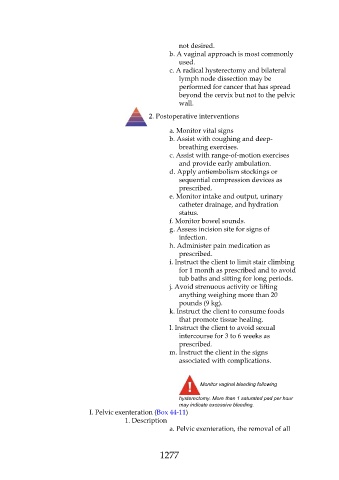Page 1277 - Saunders Comprehensive Review For NCLEX-RN
P. 1277
not desired.
b. A vaginal approach is most commonly
used.
c. A radical hysterectomy and bilateral
lymph node dissection may be
performed for cancer that has spread
beyond the cervix but not to the pelvic
wall.
2. Postoperative interventions
a. Monitor vital signs
b. Assist with coughing and deep-
breathing exercises.
c. Assist with range-of-motion exercises
and provide early ambulation.
d. Apply antiembolism stockings or
sequential compression devices as
prescribed.
e. Monitor intake and output, urinary
catheter drainage, and hydration
status.
f. Monitor bowel sounds.
g. Assess incision site for signs of
infection.
h. Administer pain medication as
prescribed.
i. Instruct the client to limit stair climbing
for 1 month as prescribed and to avoid
tub baths and sitting for long periods.
j. Avoid strenuous activity or lifting
anything weighing more than 20
pounds (9 kg).
k. Instruct the client to consume foods
that promote tissue healing.
l. Instruct the client to avoid sexual
intercourse for 3 to 6 weeks as
prescribed.
m. Instruct the client in the signs
associated with complications.
Monitor vaginal bleeding following
hysterectomy. More than 1 saturated pad per hour
may indicate excessive bleeding.
I. Pelvic exenteration (Box 44-11)
1. Description
a. Pelvic exenteration, the removal of all
1277

